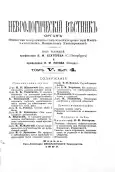The volume of changes in the nerve cells of the intervertebral nodes in the active state
- Authors: Kovalevsky V.1
-
Affiliations:
- Physiological laboratory of Kazan University
- Issue: Vol V, No 4 (1897)
- Pages: 47-58
- Section: Original article
- URL: https://journals.rcsi.science/1027-4898/article/view/46939
- DOI: https://doi.org/10.17816/nb46939
- ID: 46939
Cite item
Full Text
Abstract
The Nissl method showed that every nerve cell consists of two substances: the main one, which does not stain with this treatment, and the other, interspersed with the first, having a selective affinity for the main aniline dyes. The type, method of distribution in the nerve cell of this chromophilic substance is different depending on the nature of the group to which this nerve cell belongs. Most often, this substance is in the form of grains, differing in an extreme variety of size and shape. This new word in the study of the structure of the nerve cell gave, together with the darkness, a new basis for the study of the issue of changes in the nervous cells in the active state. Thanks to this, a number of studies by authors appeared, such as Hodge, Vas, Mann, Lambert, Lugaro, Levi, Valensa, Magini, whose purpose was to answer the question whether the nerve cells change during activity, and if they change, then what are these changes, which is, consequently, the histological picture of the process of excitation of the nerve cell. To regret, the data, which appeared to answer this question, disagree with each other. In fact, the size of the calm nerve cells, decreasing with irritation, according to Hodge, increases according to Vas and according to Lambert's opinion, they remain without changes. Chromophiles according to Vas and Lambert, moving into an irritated cell to the periphery, according to the opinion of the other authors, do not change their position. The amount of nuclear chromatin increasing along Vas decreases according to Mann. Also contradictory data and volume of changes in the size of the nucleus and nucleolus. Only one thing is that all researchers agree, this is that neither the size nor the number of chromophiles change during the appearance of irritation of the nerve cell. True, Mann says that during rest, various coloring substances accumulate in the cell, which are then consumed during activity, but this indication does not seem to refer to chromophiles, but to the chromatin of the nucleus.
Keywords
Full Text
##article.viewOnOriginalSite##About the authors
V. Kovalevsky
Physiological laboratory of Kazan University
Author for correspondence.
Email: info@eco-vector.com
Russian Federation, Kazan
References
Supplementary files











